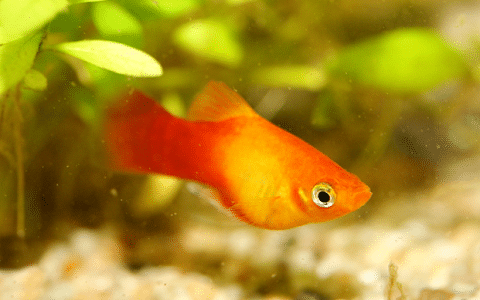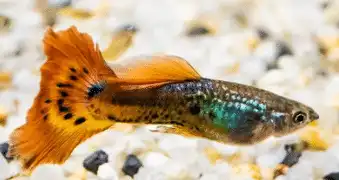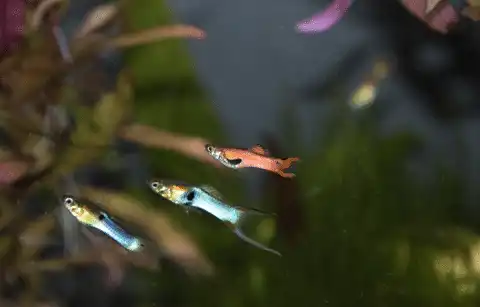Thank you for visiting! By the way… any links on this page that lead to products on Amazon and other stores/partners are affiliate links Aquarium Store Depot earns a commission if you make a purchase.
Keeping livebearers can be a fun and rewarding experience, but it’s important to know what you’re getting into before you add these fish to your tank. In this blog post, we’ll take a look at the five main types of livebearers, provide some pictures so you can identify them, and discuss care. Knowing the different types and requirements will help you make an informed decision about whether or not to keep livebearers in your tank. So without further ado, let’s get started!
What Are Livebearers?
Livebearers are often overlooked in the aquarium hobby (see video above from our YouTube Channel). Their cheap fish that are easy to keep and more experienced hobbyists see them as not being worth their time; these hobbyists have advanced onto harder and more challenging species, so there’s no reason to keep something so easy.
In our opinion, livebearers are some of the prettiest and most active fish available in the hobby and belong in every community tank setup! However, there is just one problem. There is a reason they’re known as livebearers.
There are over 300 different species of fish that are categorized as livebearers. In the aquarium hobby, the most known livebearers belong to the Poeciliidae family, including guppies, platies, mollies, and swordtails. These fish have their eggs internally fertilized and then give birth to live, free-swimming fry. This is in contrast to most other fish that lay eggs which then get fertilized.
What Is The Best Fish?
That being said, which livebearer is the best out of all of them? Well, that depends.
As we’ll see, these are some of the easiest fish to keep in the aquarium industry and one isn’t necessarily better than the next. However, each one brings a unique experience to the tank that another can’t.
For example, mollies can be adapted to live in brackish or saltwater conditions instead of freshwater, bringing a new challenge to an otherwise easy species. Many hobbyists also find it interesting to add these mundane fish to more elaborate setups with uncommon tank mates, like piranhas with common guppies.
The best livebearer fish for your aquarium setup will be the ones that match water parameters and compatibility levels.
Male Vs Female Differences
When choosing livebearers for your freshwater aquarium, it’s important to know the difference between males and females. This is for a few reasons.
- Harassment. Livebearers do not need much time between broods. Within a few weeks after birth, they’re able to safely reproduce again. This can lead to some problems with males being overly excited with females. If the ratio between male and female livebearers is low, then the females can be stressed out due to males chasing them to mate.
- Overpopulation. The biggest problem with having more than one livebearer in the aquarium is that they’ll quickly reproduce. In order to prevent this, some hobbyists stick to keeping only one sex in the aquarium.
In order to prevent harassment and overpopulation, it’s important to know the difference between male and female livebearers. In general, male livebearers are smaller and more colorful but the difference isn’t so clear with every species.
Here are the differences between the 5 main types of livebearers. Video below is also for visual reference from Albert’s Guppy Adventure:
- Guppy fish. Female guppies are plain in color, with a yellowish-brown body. The tail fin may have some coloration or patterning and the dorsal fin is short. Male guppies have colorful bodies and fins but are smaller than females. The dorsal fin is elongated.
- Endler’s livebearers. Female Endler’s are also plain in color, with a silver or tan body. The fins are usually transparent. Male Endler’s livebearers have coloring and patterning across their body and are smaller than the females.
- Platies. Platies are the most difficult fish to correctly sex on this list. Female platies have a fan shaped anal fin while male platies have a pointed anal fin. Females are also larger on average.
- Mollies. Mollies are identified in the same way as platies; females also have a modified anal fin while males have a pointed anal fin.
- Swordtails. These fish are one of the easiest to tell apart! Male swordtails have a special elongated bottom tail fin ray and a streamline body. Females lack this feature and are much rounder in appearance.
When shopping for livebearers, try to keep one male for every three females. Ask the associate to pick out male and female fish or ask them to catch specific fish to keep this ratio balanced.
5 Main Types
Out of the many various species of livebearer, five seem to be the most popular. These include:
- Guppy Fish
- Endler’s Livebearers
- Platies
- Mollies
- Swordtails
1. Guppy
An undemanding fish that is a livebearer. Many varieties available
- Scientific Name: Poecilia reticulata
- Difficulty Level: Easy
- Temperament: Peaceful
- Adult Size: 2 inches
- Minimum Tank Size: 10 gallons
- Diet: Omnivorous
- Origin: South America and parts of the Caribbean
- Temperature: 64-82°F
- pH: 5.5-8.0
- Difficulty to breed: Easy
- Planted tank suitability: Common
Guppy fish can be found everywhere and in every color. Though they originate from South America and the Caribbean, it is nearly impossible to find wild-caught individuals.
In general, there are two types of guppy: fancy guppies and feeder guppies. However, these freshwater fish aren’t different at all and are actually the same species. The only difference is that some fish are prettier and deemed as more desirable as others that might not be as big or colorful; the undesirable species get left to be fed to other fish.
Fancy guppies are usually the first fish anyone ever has. They’re colorful, small, inexpensive, and can survive most beginner mistakes. They need a minimal freshwater setup and can even survive ambient room temperatures. As a livebearer, they will quickly reproduce and overpopulate an aquarium if left unmonitored.
They should not be confused with mosquito fish, Gambusia affinis. Their lifespan can be anywhere from 2-5 years.
2. Endler’s
A very active and colorful livebearer. Smaller in size than guppies
- Scientific Name: Poecilia wingei
- Difficulty Level: Easy
- Temperament: Peaceful
- Adult Size: 1 inch
- Minimum Tank Size: 10 gallons
- Diet: Omnivorous
- Origin: Venezuela
- Temperature: 64-82°F
- pH: 5.5-8.0
- Difficulty to breed: Easy
- Planted tank suitability: Common
Endler’s livebearers are very closely related to guppies and share many of the same behaviors and care requirements, though slightly smaller and streamline in appearance. In some ways, Endler’s are more desirable than guppies and have been selectively bred to bring out the best colors and patterns.
Endler’s are nearly extinct in the wild due to run-off and habitat destruction. They have been found living together with common guppies, though they are likely to hybridize and create fertile offspring in the aquarium setting. This can be a desirable mix for some fish keepers but can also ruin a rare wild lineage of Endler’s.
3. Platies

- Scientific Name: Xiphophorus maculatus
- Difficulty Level: Easy
- Temperament: Peaceful
- Adult Size: 2 inches
- Minimum Tank Size: 20 gallons
- Diet: Omnivorous
- Origin: Central America
- Temperature: 64-77°F
- pH: 7.0-8.2
- Difficulty to breed: Easy
- Planted tank suitability: Common
Platies are a larger type of livebearer that can bring immense amounts of color and activity to the aquarium. Some varieties of platy include wagtail, salt and pepper, tuxedo, and rainbow; there is even a dwarf platy variation that is bright red for smaller nano tanks.
These fish prefer to stay towards to the top of the tank, but will venture to lower portions unlike guppies or Endler’s. It is recommended to have a larger tank for these fish as they can produce significant amounts of waste in a short period of time and like to be active.
4. Mollies

- Scientific Name: Poecilia sp.
- Difficulty Level: Easy
- Temperament: Peaceful
- Adult Size: 5 inches
- Minimum Tank Size: 30 gallons
- Diet: Omnivorous
- Origin: South America and Central America
- Temperature: 68-82°F
- pH: 7.0-8.0
- Difficulty to breed: Easy
- Planted tank suitability: Common
There are a few different species of molly available: common mollies (Poecilia sphenops), balloon mollies (Poecilia latipinna), and sailfin mollies (Poecilia latipinna). Balloon mollies have an inflated stomach and noticeably shorter body while sailfin mollies have very extended dorsal fin rays. They come in a variety of colors, including white, yellow, black, red, and dalmatian patterning.
In the wild, mollies live in brackish water conditions where rivers meet the ocean. Because so many of these fish have been bred within the aquarium hobby, most of the ones sold in stores have lived in freshwater conditions their entire lives.
However, with some patience, these fish can be acclimated to saltier conditions. In fact, some fish keepers use mollies as a way to treat pest algae in their saltwater setups. This makes them a very interesting addition to the traditional reef stocking list!
5. Swordtails

- Scientific Name: Xiphophorus helleri
- Difficulty Level: Easy
- Temperament: Peaceful
- Adult Size: 4 inches
- Minimum Tank Size: 20 gallons
- Diet: Omnivorous
- Origin: Central America
- Temperature: 64-82°F
- pH: 7.0-8.3
- Difficulty to breed: Easy
- Planted tank suitability: Common
Swordtails are probably the least popular species on this list, but that’s only because of their size. These are big fish that need to be kept in schools and many hobbyists aren’t willing to allot that real estate to a beginner fish. Still, these fish come in a bunch of vibrant colors and can bring a ton of activity to the middle and lower portions of the tank.
There are a few variations of swordtail, including lyretail and hi fin, though they are typically limited to red coloration.
Tank Setup
Livebearing fish do not need much to make them happy. The biggest problem hobbyists run into is overpopulation as the minimum recommended tank size is only 10 gallons. These nano fish tanks are good for a starting group of these fish, but will quickly become too small once the fish start to reproduce.
A 10 gallon tank is recommended for hobbyists who are able to control the populations of their fish. Otherwise, a bigger setup will be needed in the longrun.
Substrate & Decorations
Livebearers can be kept on either a sand or gravel substrate. These fish do not typically go towards the bottom of the aquarium, saving their fins and bodies from any potential injuries.
Elaborate decorations are also not needed as they will stay out in the open as long as conditions are met. On the contrary, some fish may hide when there are too few decorations available. If you find that your fish are hiding, check aquarium water parameters and add additional hiding spots.
Live plants are the best decorations you can add to your aquarium fish tank. Not only do they provide shade and coverage for your fish, but livebearing fish will also love to pick at any algae that’s growing on the leaves and stems. Not to mention the additional nutrient export and oxygenation that live plants provide!
Lighting & Filtration
Livebearers do not require any special lighting. However, since some of these fish like to stay towards the surface of the water, it’s important to keep in mind that some lighting can be too strong. To help make your top swimmers more comfortable, try adding floating plants.
In general, it’s recommended to provide fish with a filter that is rated for 2x the water volume of the tank. For livebearers, it’s better to have too much filtration as these fish quickly produce waste. Some of these tiny fish, like Endler’s, can be pushed around by an overly strong water current, though. A power filter tends to serve them well in fish only tanks while canister filters are good to invest in for heavily planted aquariums.
The Best Aquarium Power Filter
The worlds best selling and most reliable power filter on the market. Unchanged for years because it's so reliable and versatile
Heating
Livebearers are extremely hardy and will survive swings in water temperature. They can withstand cooler temperatures more than regular tropical fish and bounce back from fluctuations in water conditions. However, no fish can acclimate if temperatures change too rapidly.
Even though most livebearer fish prefer ambient room temperature, they will stress out if temperature fluctuate too often. We always recommended using an aquarium heater, even for coldwater species, to help keep warm temperatures stable rather than to raise temperature.
How To Care
Once the aquarium is mature, there is little to no additional care needed for livebearers. As mentioned before, the biggest upkeep will be keeping populations under control. This can be done by stocking either only female or male livebearers or by giving away or rehoming fry as needed.
Otherwise, aquarium maintenance is easy and straightforward.
Aquarium Maintenance
Like any fish tank, livebearers need regular water changes to help keep parameters in check. This usually means about a 20-25% water change every week or every other week. The substrate should also be siphoned during this time to remove uneaten food and other waste.
Behavior & Feeding
Livebearers are not picky and will eat anything that they can fit into their mouths. For some fish, like Endler’s, this might mean breaking up fish flakes and pellets for easier eating.
These fish are naturally omnivores and will accept both meat- and plant-based foods; this includes mosquito larvae and bloodworms as well as algae wafers and blanched vegetables.
For protein, livebearers can be given a high-quality fish flake or pellet. Floating foods may be easier for some livebearers to eat as they don’t like to go all the way down to the bottom of the tank.
Tank Mates
Most species of community fish can be kept with most livebearers. They are the ideal tank mate in regards to temperament, space requirements, and color, and can be used to accent other larger fish.
Some of these compatible species include:
- Tetras
- Danios
- Rasboras
- Gouramis
- Corydoras
- Angelfish – only with large livebearers like Swordtails and Mollies. Not Guppies.
It should also be noted that most livebearing fish can be kept with large invertebrates, like shrimp and crayfish. While this pairing isn’t always guaranteed to work, both the fish and the invertebrate tend to stay out of reach from one another.
In regards to Betta Fish, most livebearers are compatible with female bettas. Male bettas are considered with caution, with them being more successful with Endler’s livebearers due to their speed.
Tank Mates To Avoid

Livebearers are small fish. They can easily be eaten or harassed by other larger fish. Some hobbyists use this to their advantage to feed other fish and either buy or cultivate feeder guppies.
In general, you want to avoid keeping livebearers with fish that could easily swallow them. Some of these tank mates include:
Breeding
Each livebearer will be different, but the breeding process is pretty much the same for all of these aquarium fish.
First, make sure you have a group of males and females. This should be relatively easy as there is usually a big difference in appearance between male and female livebearers. When both fish are ready to spawn, they will intensify in color. Females will become noticeably rounder while males will become more persistent and aggressive.
The tank should be well-planted to ensure that newborn fry can hide and survive or else they will be eaten by their parents and other livebearers. A pregnant female will develop a dark spot near her anal fin called a gravid spot. She will be pregnant for about 4-6 weeks until she’s ready to birth up to 100 young.
These live young can be removed from the aquarium to ensure survival and to prevent inbreeding. They can be fed small foods, such as baby brine shrimp until they’re ready to accept bigger foods and rejoin the rest of the fish.
By picking and choosing which males and females you want to mate with, you can control selective breeding to get new colors and patterns.
Final Thoughts
Having easy fish doesn’t necessarily mean that you don’t know what you’re doing with your aquarium! Livebearing species are a great choice for any hobbyist at any skill level. They’re colorful, inexpensive, and incredibly active fish that can fill up an empty tank or accent other featured fish.
As long as population growth is kept in control, livebearers will enjoy grouping with themselves and foraging on algae in community tanks.
- About the Author
- Latest Posts
I’m thrilled that you found Aquarium Store Depot! Here you’ll find information on fish, aquariums, and all things aquatics related. I’m a hobbyist (being doing this since I was 11) and here to help other hobbyists thrive with their aquariums! I adhere to a high quality Editorial Process and Review products with real life field usage and practical analysis.








